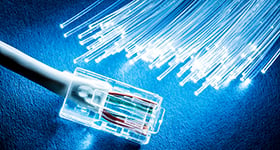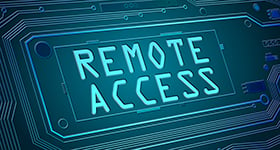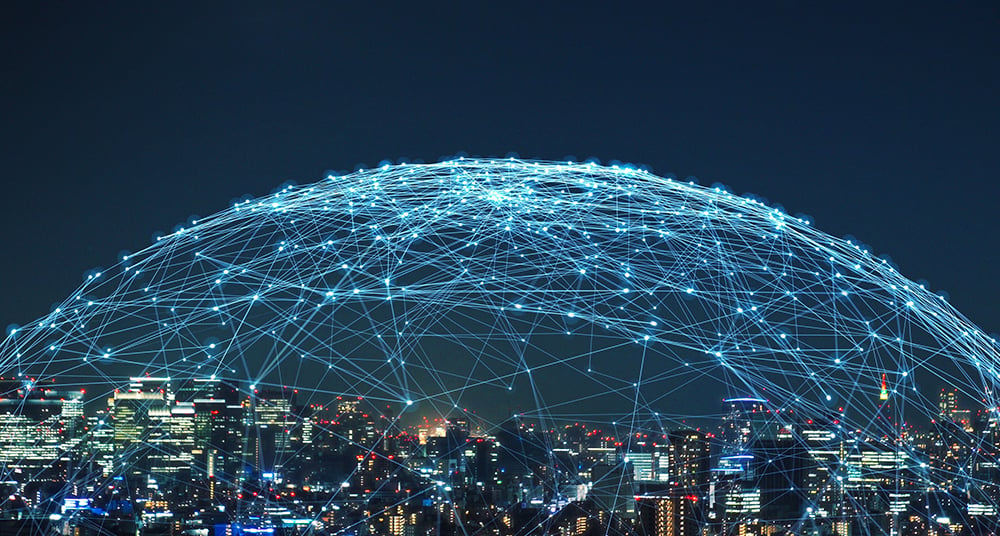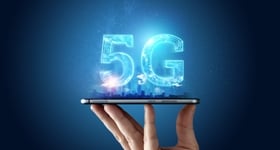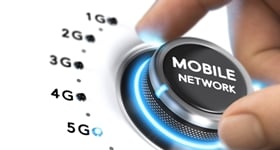There are two sides to every equation. However, focus on the accelerating global deployment of Advanced Metering Infrastructure (AMI) meters (aka smart meters) as the intelligent end points/base stations for global smart grid initiatives tend to focus on the benefits to providers of utility services and not nearly as much on consumers. Interestingly, engaging consumers on the benefits of smart meter functionality as critical to them, dramatically creates enthusiasm for smart grid deployment in general.
Reality is that if all of the benefits of smart grids are to be achieved, a better understanding by consumers as to “what’s in it for me” in the use of smart meters is critical.
Multiple studies have revealed consumer support on a general level of smart grids based on promised cost savings and helping save the environment. Yet, they are either confused because of mixed messages from the industry’s varied approaches, ill-informed, non-informed or all of the previous. An item on Earthtechling.com highlighted a recent IBM study of 10,000 people in 15 countries which found:
- 30 percent of those polled had never heard of the term “dollar per kWh (kilowatt-hour)” or the equivalent currency
- 60 percent of those surveyed were unaware of smart grids or smart meters
- Sixty-one percent of people with strong knowledge of energy technology and pricing saw smart meters and smart grids positively, compared to 43 percent of those with limited knowledge
Given where we are, and where we need to go, a lot of hard work must get done. A short list of activities the industry could employ highlights the task at hand:
- More consumer education through:
-Energy efficiency programs that highlight the general value of smart meters including how they work, why, what they do and what they do not do
-Increasing the number of home energy audits that demonstrate at the household and appliance levels how energy is consumed, and what best practices are for optimal management of consumption based on individual needs and budgets
-Dispelling of myths about the possible evils (privacy and inflated billing concerns) of having smart meters
-Hands-on physical and virtual instructions on how to use the information generated by smart meters, i.e., simple instructions on actions that can be done online versus those that still require manual actions like turning off switches and unplugging appliances
- Introduction of new pricing plans with very clear explanations of how they differ and compare with existing billing options
History: The Case for Smart Meters from a Utility Perspective
It is worth a quick review to understand the desirability of smart meters from a utility perspective in order to have insights into the current challenges they have in explaining benefits to consumers.
The first automated meter readers (AMRs) were designed to decrease the time and effort meter readers had getting access to and reading electric utility meters. Deployed in most developed countries over the past decades, it became clear that having an addressable increased intelligence device attached to a home, particularly one capable of interrogating everything that consumed household electricity, could be immensely more valuable than merely reducing truck roll time and cost.
Electricity deregulation, increasing costs for energy production and distribution to meet the demands for a more electrified (more things consuming more watts) world, global market-driven pricing (including inter-company pricing to avoid outages during peak loads in a given area), growing environmental mandates to decrease carbon footprints, have all captured first the attention and then imagination of electric utilities and their regulators. It may seem obvious but the value of the grid increases the more smart end points are attached and used.
Simply put, utilities need to better match consumption with generation. Old meters only measure total consumption and not when energy is consumed or by what. Smart meters economically measure consumption by time intervals or time-of-use —obtained from real-time or near real-time sensors — and transmit the collected data back to the utility. This allows pricing to be set based on the time-of-day and the season at the individual user level. As importantly, it provides utilities much more granular information about estimated and real-time network loads. This in turn leads to more efficient buying from partners, a greater ability to plan for future network expansions and better management of network resources during peak times and outages.
The other tangible benefits for utilities are:
- The ability to end the need for sending estimated bills to consumers, which is the largest consumer complaint and requires significant expenditures on customer service call centers
- The ability to create more billing options for customers based on consumption patterns over time, allowing more accurate yearly contracts with fixed costs and more appreciation of how variable monthly bills can be managed
- A tool for having a more intimate relationship with customers, and hence a chance to explain additional value-added services from themselves and partners
Thus, while it may seem counter-intuitive, since one of the major goals of Smart Meter deployments is to help consumers better manage consumption and thereby decrease their costs, utilities through more efficient and effective use of their plant now and going forward, are major beneficiaries as well.
Consumer Perspective: “what’s in it for me?” — Knowledge is power
It almost goes without saying, that knowledge literally and figuratively is power. From a consumer perspective, having smart meters as base stations for the smart grid should be, and must be made, obvious. They:
- As stated above, will end the era of estimated bills and thus reduce contention with userS
Provide a tool to better manage energy use and highlight where and how to cut costs, giving:
-real-time or near real-time information on a household level instead of once per month
-in the future a view at an appliance level of cost causers within a household
- Ensure billing predictability
- Are the platform for eventually totally automating cost containment and control
The goal is that smart meters attached to smart grids will provide consumers ample information to adjust their consumption habits to be more responsive to market prices.
Getting down to the appliance level may seem non-essential, but it also may be the most important aspect from a consumer perspective of all of this. For anyone who has had an energy audit by their utility, the results can be enlightening. I had one in Florida, which has high electric rates, and was able to decrease my bill 15 percent per month without any diminution of my lifestyle. It was done based on knowing which appliances used the most energy, the need to wrap my water heater better, running the dryer at night and unplugging any device not being used rather than just turning it off.
For those readers who live in the U.S. the U.S. Department of Energy has an excellent resource for estimating appliance and home electronic use that everyone should read.
Are Consumers Ready?
The answer is an almost unqualified yes. A recent study done for the Smart Grid Consumer Collaborative (SGCC) by research firm Market Strategies International highlighted that U.S. consumers rank personal and societal benefits of Smart Grid technologies as very important in their consideration, support and acceptance. The chart below from the study is revealing:
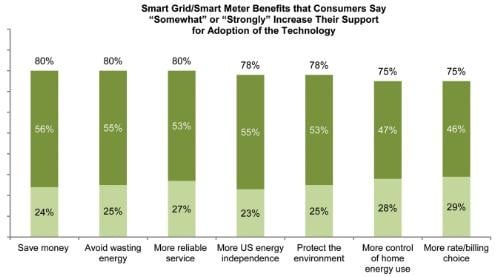
"We've found consumers to be remarkably consistent in their evaluation of the benefits commonly associated with the Smart Gridand Smart Meters," said Patty Durand, SGCC executive director. "The fact that respondents rated practical and financial concerns on par with environmental, conservation and energy independence issues tells much about what consumers value and the factors that may influence their energy decisions."
In other words, consumers are attracted to Smart Meters and Smart Grid initiatives (which other research indicates tend to be viewed as one thing by consumers) by the desirability of cutting costs, helping end U.S. dependence on foreign energy suppliers and the need for everyone to be good stewards of the environment.
Work to be Done
So if the industry sees benefits, and consumers seem to react positively, what’s the rub?
One big one that the industry must address is the privacy issue. Small but vocal minorities in Europe, particularly in the UK, have disseminated information that Smart Metering is “big brother” at his worst. They believe the primary reasons for the devices are to gather lots of personal information which in the hands of bad actors could be catastrophic, and is a ruse to raise prices.
On this subject the industry is watching a host of early deployments. The recent IBM Smart Meter Program in Dubuque, Iowa is a good example. Named “Smarter Energy Cloud,” 1,000 citizens who signed up for the program —a data study to discern consumer likes and dislikes —had Smart Meters installed in July. The Smart Meters enable users to see their energy usage through a website for a six month period. IBM was clear in its instructions to say the data, which monitors consumption every 15 minutes, will be sent securely and anonymously to its research center, and that individuals will only be able to access their own usage rates.
What observers will be keen to evaluate is user reactions to being able to not just view their usage, but changes made based on the information, and attitudes (including socialization) about their experiences. This approach of clearly stating how user information is treated has been the basis for other pilot programs. It will have to be a center piece of industry education programs that accompany smart grid and meter rollouts going forward. It should be noted that states have recognized privacy as an issue. California, where there are aggressive deployments of Smart Grid technology underway, has already adopted regulations that address precisely these concerns.
As mentioned, another problem with Smart Meter programs is a belief by some users that readings are being inflated by energy companies. When they do not see the results expected they get angry. In fact, a law suit was filed in Texas against Oncor, which just passed the 2 million smart meter mark. The suit, subsequently dismissed by a Texas District Court judge, involved skepticism over the accuracy of the readings and some associated customer service problems.
What this highlights is that there is nothing easy about smart meter deployment and the industry needs to sharpen its focus on customer perceptions and needs if this is going to be a success. As the Texas case demonstrates, a big area of education is going to be ensuring consumers paying flat monthly rates based on averaged yearly use compare apples-to-apples. Meaning, if a meter goes in a home during a high-use month and the consumer compares it to their average, the perception for those who may be confused is going to be they are paying more and that Smart Meters are of questionable value.
An Educated Consumer can be your Best Customer
The header above is a takeoff of the slogan of a well-know New York City clothing store. It happens to be a critical message to the industry. It also is a good segue back to the industry education to-do-list from above. Outreach is going to be important. Here are just a few of a myriad of things for the Smart Grid industry ecosystem —utilities, local and state governments, smart meter and smart grid technology providers, and consumer advocates— to consider:
Public Service Announcement (PSA) “did you know” campaigns. These would be a good start, as in “did you know that your clothing dryer and cable TV box can account for X percent of your monthly bill?” This could be followed with a call to consumers to contact their utility for an energy audit.
Leveraging the energy audit. Service people that interact physically with customers have always been utilities’ best sales people. Not only can they explain how to save money without the use of a Smart Meter, but they can explain what Smart Meters are, where they would go, what they would do, and how through online interaction they can have profound impact.
In addition, it allows a real person to explain:
- How customer information will be handled
- The way to evaluate a customer’s current payment plan versus the information they will see once a smart meter is deployed
- Whatever billing options, including promotional discounts, the utility is offering as an incentive to actively use the Smart Meters once installed
Advertising using happy customers. Time and effort is going to have to be spent not just on televisions advertising (especially local cable channels), but on print, bill stuffers and especially on social media. While the mix of the message should be directed at saving customers money, as the research has uncovered a message to consumers that they can do well by doing good —being environmentally conscientious — clearly is an important element of all marketing efforts.
It should also go without saying that continuing education will be key. smart meter deployment campaigns cannot have “hit-and-run” looks and feels. The more such deployments focus on “we are all in this together,” messages, the better.
Conclusions
The benefits of smart meters attached to smart grids are undeniable. This is one of those great instances that are a win/win for the industry and consumers if done correctly.
For the industry, the technology is improving. Better yet, the growth of embedded systems in household appliances means the realization of the 50+ year dream of a “smart home” that is under user control is becoming reality. And, the information from these systems will be invaluable for utilities in their facilities planning, pricing and in even customer retention in competitive markets. For the consumer, the double edged benefits of saving money while contributing to being good stewards of the environment is a powerful incentive once they know the value and are convinced that the myths are just that, myths.
The studies all point in a similar direction. The challenge for smart grids is shifting from a technology focus to marketing. Put bluntly, current marketing efforts have yielded woeful results and disconcerting results. For the full potential of the technology to be realized the entire Smart Grid ecosystem is going to have to meet the challenge presented by the facts that without better consumer education and engagement. Otherwise, the projections on savings for industry, governments and consumers will not be achieved, and an extraordinary opportunity will have been squandered.
The number of devices that consume electricity is exploding around the world. The shift from fossil fuel driven vehicles to hybrids and all electric ones is finally on its way. Hence, demand for and the per unit price of electricity are expected to continue to increase even as we migrate to alternative and more environmentally friendly energy source.
Considering what a critical paradigm shift the deployment of an expected 1Billion smart meters worldwide by 2020 represents it is fair to say that there is a lot riding on the industry doing what it needs on the non-technology front to maximize the opportunity. The good news is that marketing challenges are much easier to conquer, and key players in the smart grid ecosystem know this and are approaching the installment of Smart Meters with the attention they deserve.
Peter Bernstein is a technology industry veteran, having worked in multiple capacities with several of the industry's biggest brands, including Avaya, Alcatel-Lucent, Telcordia, HP, Siemens, Nortel, France Telecom, and others, and having served on the Advisory Boards of 15 technology startups. To read more of Peter's work, please visit his columnist page.
Edited by
Stefanie Mosca

